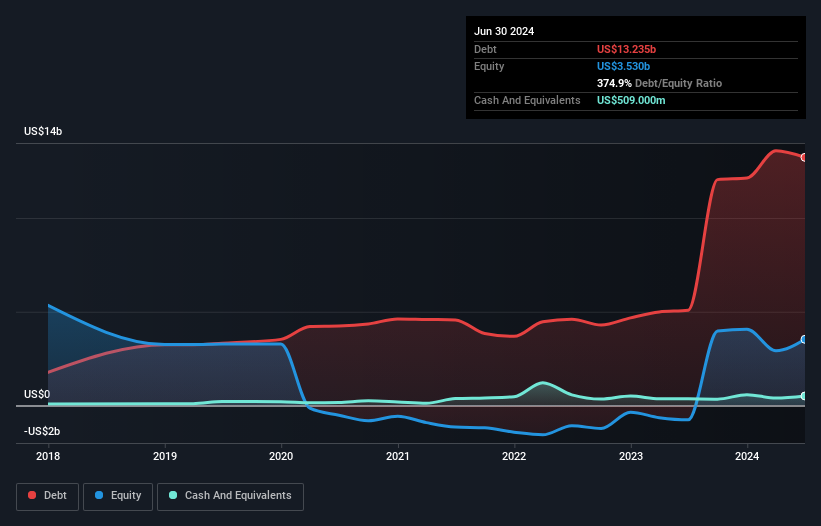- United States
- /
- Gas Utilities
- /
- NYSE:BIPC
We Think Brookfield Infrastructure (NYSE:BIPC) Is Taking Some Risk With Its Debt

David Iben put it well when he said, 'Volatility is not a risk we care about. What we care about is avoiding the permanent loss of capital.' So it might be obvious that you need to consider debt, when you think about how risky any given stock is, because too much debt can sink a company. Importantly, Brookfield Infrastructure Corporation (NYSE:BIPC) does carry debt. But is this debt a concern to shareholders?
When Is Debt Dangerous?
Generally speaking, debt only becomes a real problem when a company can't easily pay it off, either by raising capital or with its own cash flow. Part and parcel of capitalism is the process of 'creative destruction' where failed businesses are mercilessly liquidated by their bankers. However, a more usual (but still expensive) situation is where a company must dilute shareholders at a cheap share price simply to get debt under control. Of course, debt can be an important tool in businesses, particularly capital heavy businesses. The first step when considering a company's debt levels is to consider its cash and debt together.
View our latest analysis for Brookfield Infrastructure
How Much Debt Does Brookfield Infrastructure Carry?
As you can see below, at the end of June 2024, Brookfield Infrastructure had US$13.2b of debt, up from US$5.08b a year ago. Click the image for more detail. However, it does have US$509.0m in cash offsetting this, leading to net debt of about US$12.7b.

How Strong Is Brookfield Infrastructure's Balance Sheet?
The latest balance sheet data shows that Brookfield Infrastructure had liabilities of US$5.20b due within a year, and liabilities of US$14.9b falling due after that. Offsetting these obligations, it had cash of US$509.0m as well as receivables valued at US$2.56b due within 12 months. So its liabilities total US$17.1b more than the combination of its cash and short-term receivables.
This deficit casts a shadow over the US$6.00b company, like a colossus towering over mere mortals. So we'd watch its balance sheet closely, without a doubt. After all, Brookfield Infrastructure would likely require a major re-capitalisation if it had to pay its creditors today.
In order to size up a company's debt relative to its earnings, we calculate its net debt divided by its earnings before interest, tax, depreciation, and amortization (EBITDA) and its earnings before interest and tax (EBIT) divided by its interest expense (its interest cover). Thus we consider debt relative to earnings both with and without depreciation and amortization expenses.
While Brookfield Infrastructure's debt to EBITDA ratio (4.7) suggests that it uses some debt, its interest cover is very weak, at 2.3, suggesting high leverage. It seems clear that the cost of borrowing money is negatively impacting returns for shareholders, of late. Looking on the bright side, Brookfield Infrastructure boosted its EBIT by a silky 53% in the last year. Like a mother's loving embrace of a newborn that sort of growth builds resilience, putting the company in a stronger position to manage its debt. When analysing debt levels, the balance sheet is the obvious place to start. But it is future earnings, more than anything, that will determine Brookfield Infrastructure's ability to maintain a healthy balance sheet going forward. So if you're focused on the future you can check out this free report showing analyst profit forecasts.
Finally, a business needs free cash flow to pay off debt; accounting profits just don't cut it. So it's worth checking how much of that EBIT is backed by free cash flow. In the last three years, Brookfield Infrastructure's free cash flow amounted to 28% of its EBIT, less than we'd expect. That weak cash conversion makes it more difficult to handle indebtedness.
Our View
Mulling over Brookfield Infrastructure's attempt at staying on top of its total liabilities, we're certainly not enthusiastic. But on the bright side, its EBIT growth rate is a good sign, and makes us more optimistic. It's also worth noting that Brookfield Infrastructure is in the Gas Utilities industry, which is often considered to be quite defensive. Looking at the bigger picture, it seems clear to us that Brookfield Infrastructure's use of debt is creating risks for the company. If all goes well, that should boost returns, but on the flip side, the risk of permanent capital loss is elevated by the debt. There's no doubt that we learn most about debt from the balance sheet. However, not all investment risk resides within the balance sheet - far from it. We've identified 4 warning signs with Brookfield Infrastructure (at least 1 which makes us a bit uncomfortable) , and understanding them should be part of your investment process.
When all is said and done, sometimes its easier to focus on companies that don't even need debt. Readers can access a list of growth stocks with zero net debt 100% free, right now.
Valuation is complex, but we're here to simplify it.
Discover if Brookfield Infrastructure might be undervalued or overvalued with our detailed analysis, featuring fair value estimates, potential risks, dividends, insider trades, and its financial condition.
Access Free AnalysisHave feedback on this article? Concerned about the content? Get in touch with us directly. Alternatively, email editorial-team (at) simplywallst.com.
This article by Simply Wall St is general in nature. We provide commentary based on historical data and analyst forecasts only using an unbiased methodology and our articles are not intended to be financial advice. It does not constitute a recommendation to buy or sell any stock, and does not take account of your objectives, or your financial situation. We aim to bring you long-term focused analysis driven by fundamental data. Note that our analysis may not factor in the latest price-sensitive company announcements or qualitative material. Simply Wall St has no position in any stocks mentioned.
About NYSE:BIPC
Brookfield Infrastructure
Owns and operates regulated natural gas transmission systems in Brazil.
Good value unattractive dividend payer.


